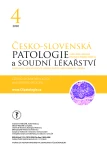Comments on the 5th edition of WHO classification of digestive system tumors – Part 1. Gastrointestinal tract
Authors:
Ondřej Daum 1,2
; Magdaléna Daumová 1,2; Marián Švajdler 1,2
Authors place of work:
Šiklův ústav patologie LF UK a FN Plzeň
1; Bioptická laboratoř s. r. o., Plzeň
2
Published in the journal:
Čes.-slov. Patol., 56, 2020, No. 4, p. 194-206
Category:
Přehledový článek
Summary
The new 2019 WHO classification of digestive system tumors reflects some important advancements in our understanding of etiopathogenesis and molecular background of selected neoplastic diseases of the gastrointestinal tract, offers more integrated review of non-epithelial neoplasms and updates the spectrum of genetic tumor syndromes of the digestive system. Recently recognized conditions, such as gastroblastoma and “gastric adenocarcinoma and proximal polyposis of the stomach” are described, including molecular alterations associated with these entities. On the other hand, the new interpretation of some topics, mainly grading of serrated lesions or ICD-O coding of adenomas and dysplasia, is rather controversial. Last but not least, the definition of pTis in the large intestine according to WHO conflicts its definition according to AJCC/UICC TNM classification, 8th edition, issued in 2017.
Keywords:
Gastrointestinal tract – Digestive system – tumors – WHO classification
Zdroje
1. WHO Classification of Tumours Editorial Board. Digestive system tumours (5th ed). Lyon, France: IARC; 2019.
2. Amin MB. AJCC Cancer staging manual (8th ed). New York: Springer; 2017.
3. Brierley JD, Gospodarowicz MK, Wittekind C. TNM Klasifikace zhoubných novotvarů (8. vydání). Praha, ČR: ÚZIS; 2018.
4. Pant M, Pehlivanoglu B, Erbarut-Seven I, Adsay NV. Intra-ampullary papillary-tubular neoplasm: an update on the ampullary counterparts of pancreatobiliary intraductal neoplasms. AJSP: Reviews & Reports 2018; 23(1): 38-43.
5. Pai RK, Bettington M, Srivastava A, Rosty C. An update on the morphology and molecular pathology of serrated colorectal polyps and associated carcinomas. Mod Pathol 2019; 32(10): 1390-1415.
6. Carr NJ, Bibeau F, Bradley RF, et al. The histopathological classification, diagnosis and differential diagnosis of mucinous appendiceal neoplasms, appendiceal adenocarcinomas and pseudomyxoma peritonei. Histopathology 2017; 71(6): 847-858.
7. Laine L, Kaltenbach T, Barkun A, et al. SCENIC international consensus statement on surveillance and management of dysplasia in inflammatory bowel disease. Gastroenterology 2015; 148(3): 639-651.
8. Toon CW, Chou A, DeSilva K, et al. BRAFV600E immunohistochemistry in conjunction with mismatch repair status predicts survival in patients with colorectal cancer. Mod Pathol 2014; 27(5): 644-650.
9. Castle PE, Adcock R, Cuzick J, et al. Relationships of p16 immunohistochemistry and other biomarkers with diagnoses of cervical abnormalities: implications for LAST terminology. Arch Pathol Lab Med 2019, In press.
10. Daumová M, Vaňková B, Švajdler M, Michal M, Daum O. Imunohistochemie a molekulární genetika v diferenciální diagnostice mezenchymálních lézí gastrointestinálního traktu. Cesk Patol 2020, In press.
11. Agaimy A, Stoehr R, Vieth M, Hartmann A. Benign serrated colorectal fibroblastic polyps/intramucosal perineuriomas are true mixed epithelial-stromal polyps (hybrid hyperplastic polyp/mucosal perineurioma) with frequent BRAF mutations. Am J Surg Pathol 2010; 34(11): 1663-1671.
Štítky
Patologie Soudní lékařství ToxikologieČlánek vyšel v časopise
Česko-slovenská patologie

2020 Číslo 4
Nejčtenější v tomto čísle
- Chtěl jsem být bankovní lupič, ale nevěděl jsem, kde se na to studuje
- Novinky v páté verzi WHO klasifikace nádorů trávicího systému – 1. Gastrointestinální trakt
- Prof. MUDr. Ľudovít Danihel, PhD. jubiluje.
- Novinky v histopatologické klasifikaci neuroendokrinních nádorů v 5. vydání WHO klasifikace nádorů trávicího traktu (2019)
